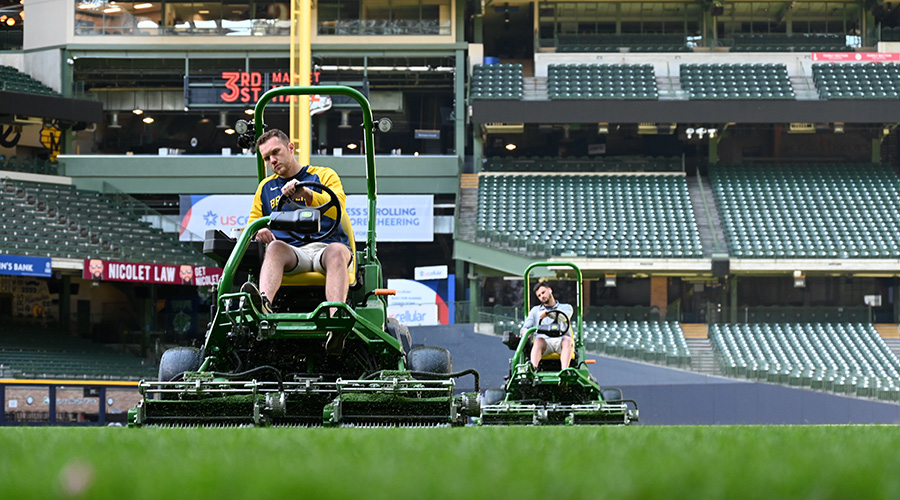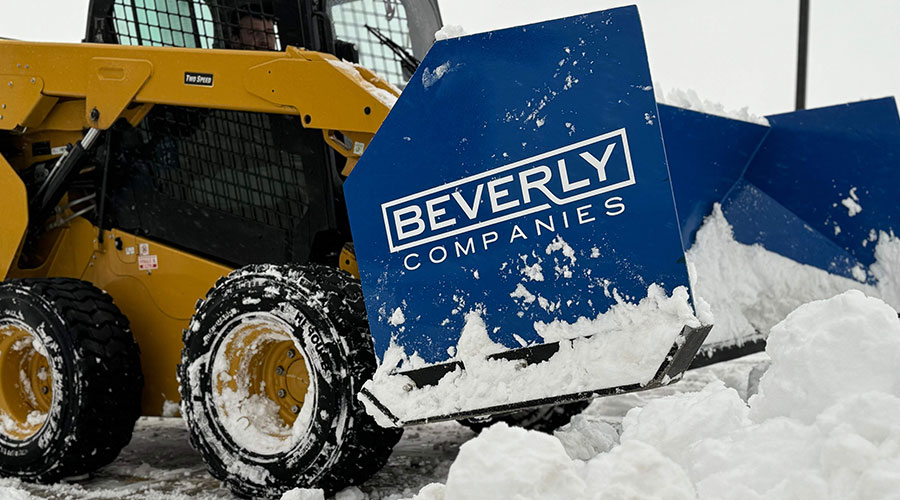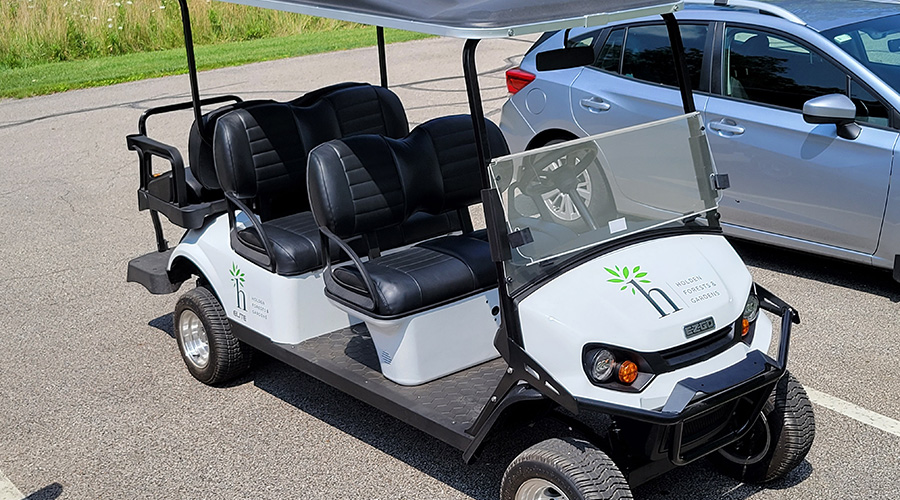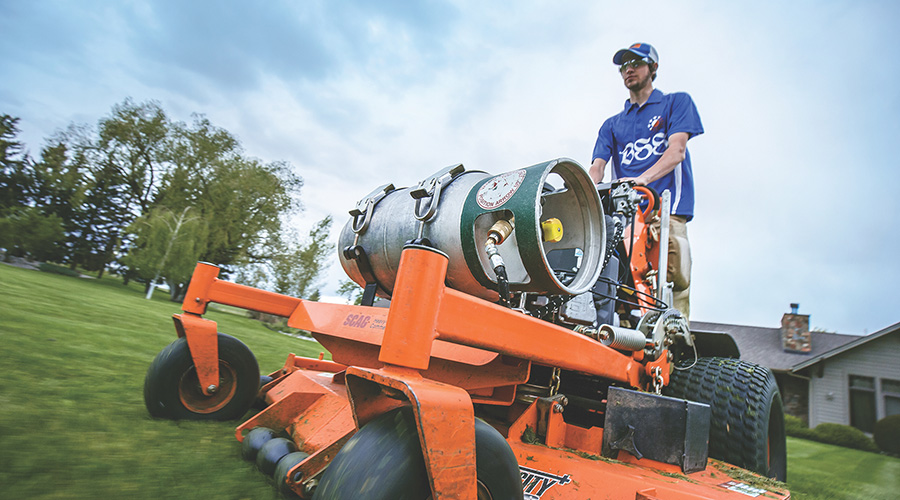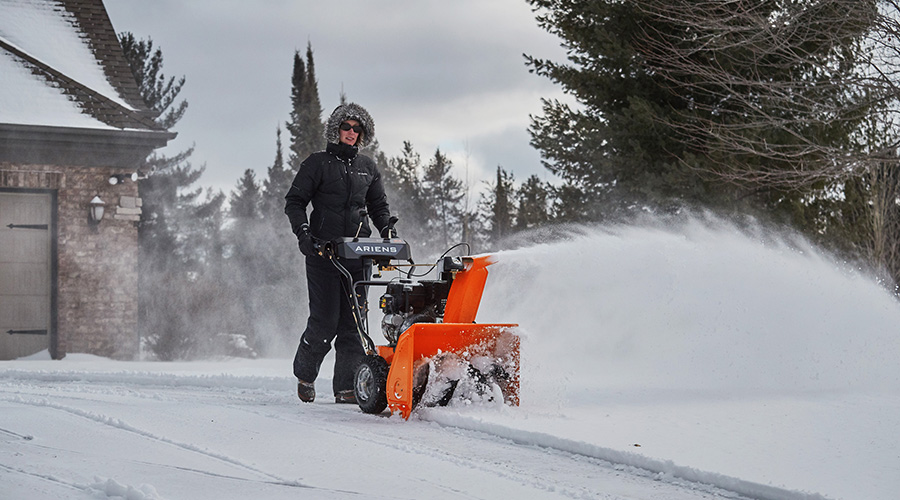Inside Grounds Crew Operations for the Milwaukee Brewers
Grounds crew keeps American Family Field ready for Milwaukee Brewers to play ball.
By Dave Lubach, Executive Editor
“A baseball field must be the most beautiful thing in the world. It’s so honest and precise. And we play on it,” Jim Lefebvre, former Major League Baseball player, coach and manager.
A group of reporters had gathered on the warning track along the first-base line at American Family Field to speak with a senior member of the Milwaukee Brewers’ grounds crew team about preparations for the Major League Baseball (MLB) team’s opening day game in April.
The news conference was designed to give the community a behind-the-scenes look at what happens to get the field ready for the baseball season, and one rule was hard and fast for the reporters and camera people in attendance: “Do not step on the field.”
Baseball fields are often treated as sacred ground, and that is especially true for an MLB stadium. Thousands of dollars and hundreds of hours of labor are invested in keeping the field looking lush, pristine and safe for the players over 80-plus baseball games every season. Any unnecessary traffic on the grass, even minor and brief, threatens that goal.
While grounds crews are responsible for several duties on game days, one key duty is mowing the outfield and infield grass. But the preparation is a year-round effort that goes well beyond mowing on the day of the game.
Staffing setup
As the Brewers’ senior director of grounds, Ryan Woodley gets a lot of calls and texts from neighbors and friends seeking advice on taking care of their lawns. Considering his high-profile position, he takes the inquiries good-naturedly.
“Everybody for the most part takes pride in mowing their yards and thinks it’s the coolest job to do it on a national stage and be on TV every night,” says Woodley, an Iowa native who interned with the Brewers in 2008 and returned to the team in 2018. “But people don’t realize how big our staff is and how many hours our staff puts in to get all these events in.”
Woodley manages seven full-time employees who handle landscaping and turf issues year-round, giving the Brewers one of the bigger grounds staffs in MLB. He needs it, because in addition to maintaining grassy areas in the parking lots and other parts of the grounds around American Family Field, Woodley's team maintains a little league field adjacent to the stadium.
The grounds staff increases to 45 employees during the baseball season to keep the fields and grounds looking their best. Staffing is also dictated by other events the stadium is hosting, such as concerts, corporate events, batting practice and fantasy camps.
“We take care of all the landscaping outside, all the snow removal, dealing with contractors, all that stuff,” Woodley says. “We’re fortunate to have good contractors to use for a lot of that stuff outside the stadium. It’s not just the 2 acres inside (American Family Field).”
Game day preparation
The Brewers deploy a modest fleet of mowers for the field, including two ride-ons that handle the outfield and two walk-behinds that handle the infield area. While it seems like more mowers would be required to cover 100,000 square feet of mowing area on the field – 80,000 of which is the outfield — the mowers receive quite a workout.
“Every day there’s a game, we’re mowing everything just to make sure the grass is consistent because it grows every day,” Woodley says. “When the team goes on the road, it’s event-driven based on whatever we have going on that day. We may go a few days without mowing.”
A typical game day for Woodley’s team is a 10-12-hour shift that includes such duties as dragging the infield and the warning track, preparing the pitching mounds and bullpens, setting up for batting practice, cleaning up sunflower seeds and other debris that finds its way on to the playing field, and of course, mowing.
The grounds staff typically arrives at 8 a.m. for an evening game with a goal of having all mowing done by 10 a.m.
“Sometimes, we’ll have to double cut if the grass is really taking off, but it’s not very often,” Woodley says.
During a typical three-game home series, the grounds staff follows a rotation for mowing the outfield. On the first day, the crew mows straight from the infield to the outfield walls. On the second day, the crew mows from foul pole to foul pole, and on the third day, they mow in an arc pattern.
“We’ll keep the same pattern throughout the year to keep it consistent,” Woodley says. “Two guys in the outfield and two guys on the infield sidelines. Player safety is our top priority and making sure they have good footing. The players want consistency and don’t want something to change from homestand to homestand. We have conversations with the players throughout the season to have that open dialogue with them if they’re not happy with something.”
The staff keeps the grass 1 inch high for games, a height that Woodley compares to the height of the rough at a municipal golf course. Contrary to the adage that baseball teams alter the height of their field to adjust to the strengths and weaknesses of their opponents, Woodley says that is not the case.
Controlling growth
American Family Field's retractable roof allows the Brewers to play games despite inclement weather, but that does not mean the roof is always open when it rains.
“We try to get the roof open as much as we can, but we also realize that we have events that we have to do, so we really don’t try to take on any rain during the season,” Woodley says, relying on technology like grow lights to help with the growing process.
The team also works with two local meteorologists to determine the best time to open the roof for games and to give the field grass some light.
Once the season ends, the turf care and mowing continue. Woodley allows the grass to grow a bit during winter and reduces mowing to once or twice a week, depending on the growth.
The outfield is covered with blankets starting in late December, enabling the grass to stay warm and retain moisture. Preparing for opening day begins a few weeks before the season when the blankets are removed.
The team changed plans slightly this past off-season as it installed two new scoreboards that required the use of cranes in the outfield and forced the roof to be open more than usual.
Woodley also used the off-season to incorporate GrassMax stitching into the outfield mix, which is otherwise 100 percent Kentucky Bluegrass. The stitching makes up 5 percent of the field and is designed to help the grass recover better from events like concerts and give the players yet another layer of safety.
Woodley describes the stitching as a giant sewing machine that is the first of its kind in MLB. It is a technology used by the Green Bay Packers for Lambeau Field and European soccer teams for their fields.
Opportunities to work with new technologies like the grow lamps, stitching, new mixes for infield dirt and the advances in mower technologies keep Woodley and his team among the best grounds crews in the majors
“Nothing that we do here is spur of the moment,” he says. “We have expectations of where we should be at a certain time. As long as we’re on track with that and everybody’s on the same page, we’ll be successful.”
Dave Lubach is the executive editor of the facilities market. He has more than nine years of experience writing about facility management and maintenance issues.
Related Topics:








